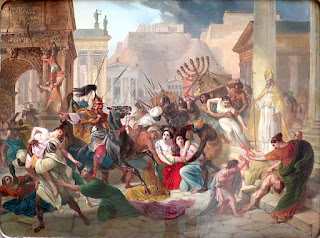With the intention to restore Hilderic to the throne, the Byzantine Emperor Justinian I sent an army to North Africa. This was the start of the 533-34 Vandalic War, Justinian's attempt at reconquest of the Western Roman Empire. The Byzantines had a stroke of luck: the Vandal army wasn't home.
The Vandal army was on its way to Sardinia to deal with a rebellion there, led by Gelimer's brother. Seeing the Byzantine army approaching, Gelimer tried to gather what remaining forces he had, but they were insufficient to stop the Byzantines, led by Belisarius, from conquering the vandal capital of Carthage.
On 15 December 533, the two armies met again 20 miles from Carthage. When the Vandal leader Tzar (Gelimer's brother) fell, the army scattered. Belisarius advanced to the Vandal second capital of Hippo Regius, occupying it with little resistance. Gelimer surrendered in 534, and the Kingdom of the Vandals was no more. North Africa was once more a Roman province.
So what happened then? Gelimer was offered estates in Galatia (Hilderic had been killed in prison). He was offered the rank of patrician, but he would have had to convert to Catholicism, and so refused. The Vandal soldiers were shipped to Constantinople to become a unit in the Byzantine army. The best warriors became a cavalry regiment called the Justinian Vandals, or Vandali Iustiniani, and were sent to the Persian frontier. With Byzantine soldiers staying in North Africa to maintain the imperial presence, many married Vandal women.
Some Vandals migrated back to the Iberian Peninsula. One of them, Guntarith, came back in 546 with Moorish support and killed the proconsul of the African province in Carthage. His takeover of Carthage did not last long: he was assassinated by resident Byzantines and his Moorish counterpart, Stotzas the Younger, was taken to Constantinople and executed. That was the last gasp of the Vandal Kingdom that harried Europe and Rome.
One of the only contemporary accounts of the Vandal interaction with the Roman Empire is by Prosper of Aquitaine, who is relied on for the late 4th to mid-5th century. I'll tell you more about him next time.


























